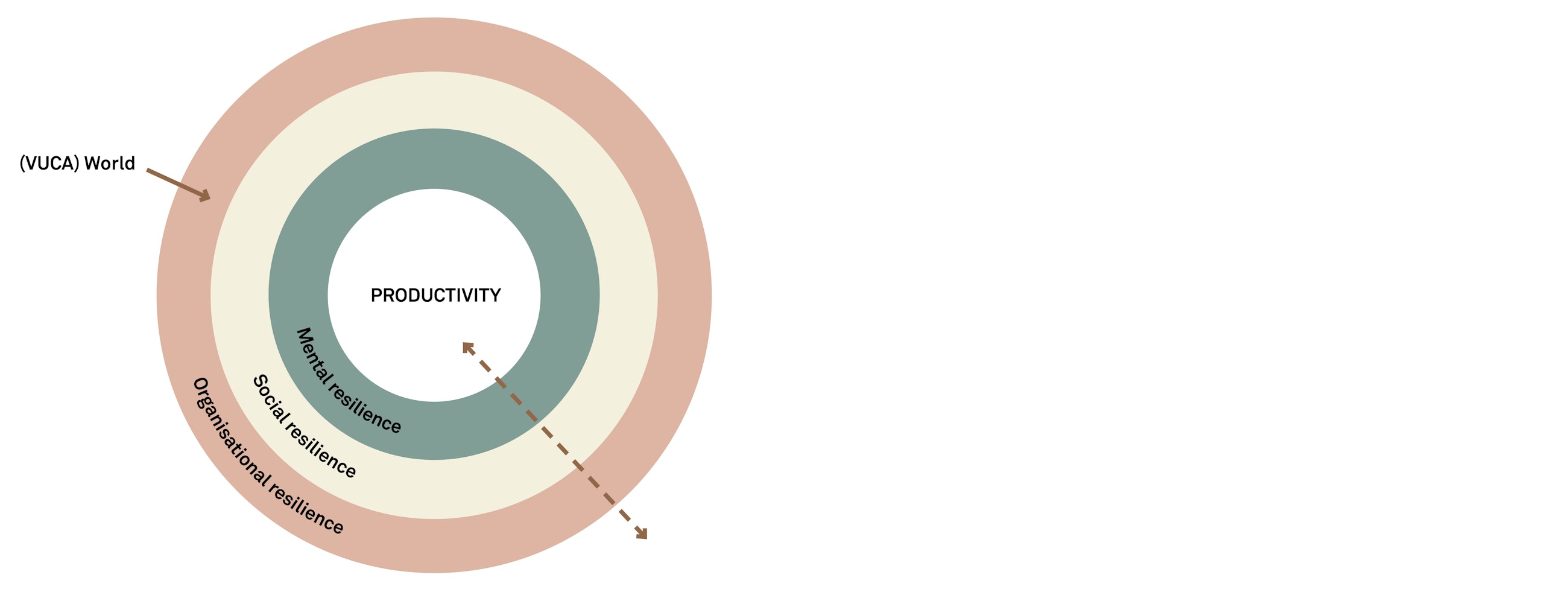Do you want to increase productivity in your business?
11 July 2016
As a manager, you can contribute to boosting productivity. However, it requires you to rethink the situation that you and your employees are in.
Maybe you’re already focusing on operations optimisation, distribution of work, automation and rationalisations, all of which are initiatives with the one thing in common that they’re going to reduce the amount of manpower per unit of production. In this article, we will explore how to increase productivity in a new way by focusing on building resilience in your business at an organisational, social and mental level, respectively. Productivity leads to prosperity and welfare. To put it simply, the higher the productivity, the more opportunities we have.
Since the mid-1990s, Danish companies have lost ground due to growth in productivity of less than 1% per year. If Danish productivity had kept pace with that of the US, we, as a society, could have increased our wealth by DKK 360 billion in 2013. An average employee would have earned DKK 3,000 more per month after taxes. We could have built eight new super hospitals a year and doubled the number of teachers in first to fourth form. The weak productivity trend means that Denmark has missed out on a number of opportunities, and if we fail to improve productivity, our prosperity and welfare are going to be on the decline.1
So, what is the productivity level of your business? Are you able to seize the opportunities that arise in the form of new technology, knowledge, demographics and market conditions domestically and internationally? And do you focus your efforts across the entire business on making it resilient and sustainable to achieve the best possible results? If you’re hesitant to answer, you may want to read on.
Resilience as a productivity factor
Basically, we as people are productive and contributing human beings. When we’re faced with a task, the task and its solution provide us with meaning as a concrete productive activity.2 However, it requires us to overcome the challenge to enable us to see that it can be resolved in a satisfactory manner. Thus, our belief in ourselves grows stronger when it comes to handling future tasks.3 If you as a manager want to increase the level of meaning, thus increasing productivity, you should focus your efforts on building resilience in your business at several levels (see model).
We have developed a model for productive resilience to illustrate several elements that may contribute to increased productivity. The model is supported by research on resilience and positive psychology where the positive purpose is to optimise the individual person’s and the organisation’s optimal functioning.4 Today resilience is a concept that is quickly gaining ground in large multinational companies such as Shell, IBM, Siemens, DuPont and Unilever, who are debating which initiatives are needed to create more long-lasting and resilient societies and economies.5 In the following, we will elaborate on the model and illustrate how to use it in practice.
Focus on strategic choices through resilience
Resilient organisations are able to maintain or restore their structure and function under extreme pressure as they absorb the disruption. They can respond quickly to feedback and in a flexible way convert and distribute knowledge and resources without losing their identity,6 while still delivering bottom line results. In short, resilient organisations are able to navigate in a “VUCA world”, which is characterised by volatility, uncertainty, complexity and ambiguity as well as attention and readiness for this world.7
Roger Martin, who is one of the world’s top management thinkers, has described strategy as an integrated cascade of choices at corporate level, sector level and individual brand level. In an unpredictable world, it’s only by continuously making choices and acting on them that we can be productive, see the way forward and focus on what’s important.8 So, how would you describe your organisation’s decision-making process? And what is the level of quality of the choices you make? These are key questions that need answers and a focal point if you want to build a resilient and productive organisation.
As a manager, you make many important choices every day, by yourself and with others. The concept of “social resilience” is a new and unexplored concept we are discussing and working with in practice. It’s about the ability to collectively be able to adapt to changing circumstances through effective choices. It’s a social capacity that requires strong relations and a constructive, common mental framing of reality. If you are to accept reality as it is, you need to look at it clearly and not let your interpretations get disrupted by negative, fixed and distorted thinking patterns. It may prevent you from making good, strategic choices.
Thinking traps and mental resilience
To support strategic choices, it’s a good investment to train your mental resilience which is to support these choices. Based on the cognitive part of the research on resilience,9 we know that the following three factors come into play before we make choices:
- Adversity (the situation or event)
- Beliefs (thoughts)
- Consequences (feelings and behaviours)
According to the ABC model, our actions are not a direct consequence of the situation but of how we interpret the situation. Therefore, it’s first and foremost about identifying challenges and secondly about identifying the thoughts and feelings in the situation, and what is going to influence the individual person’s choice. Here you can ask yourself or others the question: “What am I/are you thinking right now?”
The answer can guide you in your search for thoughts that connect A (if this happens) with C (I will make this choice). Once you get into the right mindset, you can begin to influence the B-C connections and thus the mental resilience and capacity. The challenging part of the approach is the thinking traps that each of us risks falling into when we reduce complexity by taking automatic, mental shortcuts in our thinking.10 Typically, there are eight thinking traps we all fall into – and most often it’s the same two or three traps we tend to be most vulnerable to. However, we’re able to build up the ability to make more mentally resilient and realistic choices if we become conscious of the traps.
Thinking traps
- Jumping to conclusions
- Simplification
- Magnifying/minimising
- Personalising (we assume blame/“me thinking”)
- Externalising (we blame others/“not me” thinking)
- Overgeneralising
- Mind-reading (we assume that we know what others are thinking)
- Emotional reasoning
Productivity is about input and output. Once you’re able to recognise thinking traps, you can disrupt them towards a more effective mental output. For example, you can ask yourself: Am I jumping to conclusions? Can you see this from another point of view? These are questions that can disprove the above thinking traps 1 and 2. Thus, you can contribute to changed thinking patterns as the basis for more focused choices.
Seize the VUCA challenges!
Productivity is about being able to make strategic choices throughout the organisation, free of captivating thinking patterns. Thereby, the individual is also liberated. As a manager, you’re off to a good start if you’re working with resilience. However, if you ask us, building resilience in organisations is not something that lies on the shoulders of one person or something you can isolate. Resilience is a concept you can work on at an individual, social and organisational level with multiple meanings. Thus, you build up psychological capital in your business so that it’s strengthened in the best possible way to resist and overcome the challenges you will inevitably encounter in a VUCA world – while being productive.
We wish you all the best!
References
1 Produktivitetskommissionen (2014). ”Det handler om velstand og velfærd”. Final report. http://produktivitetskommissionen.dk/media/165599/slutrapport02042014.pdf
2 Sørensen, O., Hasle, P., Hesselholt, R. R. og Herbøl, K. (2012). ”Nordiske forskningsperspektiver på arbejdsmiljø. Mening, indflydelse og samarbejde”. Nordisk Ministerråd.
3 Bandura, A. (1997). Self-Efficacy: The Exercise of Control. New York: W. H. Freeman.
4 Seligman, M. E. P. (2002). Authentic Happiness: Using the New Positive Psychology to Realize Your Potential for Lasting Fulfillment. New York: Free Press.
5 Resilience Action Initiative (RAI). World Economic Forum 2013.
6 Walker, B., Holling, C. S., Carpenter, S. R. og Kinzig, A. (2004). Resilience, Adaptability and Transformability in Social–ecological Systems. Ecology and Society 9(2), 5.
7 Johansen, B. (2007). Get There Early: Sensing the Future to Compete in the Present. San Francisco, CA: Berrett-Koehler Publishers, Inc.
8 Lafley, A. G. og Martin, R. (2013). Playing to Win: How Strategy Really Works. Boston: Harvard Business Review Press.
9 Reivich, K. og Shatté, A. (2002). The Resilience Factor: 7 Keys to Finding Your Inner Strength and Overcoming Life’s Hurdles. New York: Random House.
10 Kahneman, D. (2013). At tænke – hurtigt og langsomt. Lindhardt og Ringhof.





